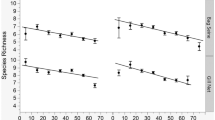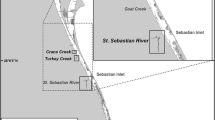Abstract
Evaluating the effects of anthropogenic activities is dependent upon data collection prior to impact, though funds are rarely allocated to conduct an assessment before a critical need arises. The Savannah Harbor Expansion Project is one such activity that includes dredging of the Savannah River. It may potentially change physical conditions of the estuary thereby altering fish assemblages. The purpose of the present study was to characterize pre-impact fish assemblages along a salinity gradient near the mouth of the river and determine which abiotic factors most influence them. One site within the mouth of the Savannah River and two sites immediately outside the river mouth were sampled monthly for 2 years using both a beam trawl and seine net. Salinity, temperature, dissolved oxygen, and sediment grain size were assessed. All four factors had a significant effect on fish assemblages. A total of 3943 fishes representing ≥55 species formed three statistically distinct fish assemblages and at least three seasonal assemblages. Only 24 species (43.6 %) were collected by both gear types indicating the importance of using multiple gear types to assess fish assemblages. We conclude that the fish assemblages near the mouth of the Savannah River may be altered or may shift given the predicted increase in salinity and/or the possible changes in sediment composition from channel dredging. Understanding the abiotic factors that most influence spatial and seasonal fish distributions prior to dredging will be invaluable in predicting how organisms will be impacted by similar public projects elsewhere.



Similar content being viewed by others
References
Allen, D.M., and D.L. Barker. 1990. Interannual variations in larval fish recruitment to estuarine epibenthic habitats. Marine Ecology Progress Series 63: 113–125.
Anderson, J.D., and W.J. Karel. 2007. Genetic evidence for asymmetric hybridization between menhadens (Brevoortia spp.) from peninsular Florida. Journal of Fish Biology 71: 235–249.
Bell, G.W., and D.B. Eggleston. 2005. Species-specific avoidance responses by blue crabs and fish to chronic and episodic hypoxia. Marine Biology 146: 761–770.
Bilkovic, D.M. 2011. Response of tidal creek fish communities to dredging and coastal development pressures in a shallow-water estuary. Estuaries and Coasts 34: 129–147.
Bray, J.R., and J.T. Curtis. 1957. An ordination of upland forest communities of southern Wisconsin. Ecological Monographs 27: 325–349.
Clarke, D.G., J. Homziak, R. Lazor, M.R. Palermo, G.E. Banks, H.A. Benson, B.H. Johnson, T. Smith-Dozier, G. Revelas, and M.R. Da.rdeau. 1990. Engineering design and environmental assessment of dredged material overflow from hydraulically filled hopper barges in Mobile Bay, Alabama. Miscellaneous Paper D-90-4. US Army Engineers Waterways Experiment Station, Vicksburg, MS.
da Silva, D.R. Jr, S.R. Santos, M. Travassos, and M. Vianna. 2012. Impact on a fish assemblage of the maintenance dredging of a navigation channel in a tropical coastal ecosystem. Brazilian Journal of Oceanography 60(1): 25–32.
De Robertis, A., C.H. Ryer, A. Veloza, and R.D. Brodeur. 2003. Differential effects of turbidity of prey consumption of piscivorous and planktivorous fish. Canadian Journal of Fisheries and Aquatic Sciences 60: 1517–1526.
Desprez, M. 2000. Physical and biological impact of marine aggregate extraction along the French coast of the eastern English Channel: short- and long-term post-dredging restoration. ICES Journal of Marine Science 57: 1428–1438.
DuBeck, G.D., and M.C. Curran. 2007. The seasonal use of a shallow Georgia creek by flatfishes. Georgia Journal of Science 65(4): 170–181.
Folk, R.L. 1968. Petrology of sedimentary rocks: Austin, University of Texas Publication, 170 p.
Fossen, I., C.F. Cotton, O.A. Bergstad, and J.E. Dyb. 2008. Species composition and distribution patterns of fishes captured by longlines on the Mid-Atlantic Ridge. Deep-Sea Research II 55: 203–217.
Güt, J.A. 2015. Characterizing and comparing fish assemblages near the mouth of the Savannah River, 82 p. Georgia. M.S. Thesis: Savannah State University, Savannah, GA.
Johnson, B.H., M.J. Trawle, and P.G. Kee. 1989. A numerical model study of the effect of channel deepening on shoaling and salinity intrusion in the Savannah estuary. Technical Report HL-89-26. US Army Engineer Waterways Experiment Station, Vicksburg, MS.
Johnston, S.A. Jr. 1981. Estuarine dredge and fill activities: a review of impacts. Environmental Management 5(5): 427–440.
Katsanevakis, S., C.D. Maravelias, D. Damalas, A.P. Karageorgis, E.V. Tsitsika, C. Anagnostou, and C. Papaconstantinou. 2009. Spatiotemporal distribution and habitat use of commercial demersal species in the eastern Mediterranean Sea. Fisheries Oceanography 18(6): 439–457.
Lasiak, T.A. 1984. Structural aspects of the surf-zone fish assemblage at King’s Beach, Algoa Bay, South Africa: long-term fluctuations. Estuarine, Coastal and Shelf Science 18: 459–483.
Martino, E.J., and K.W. Able. 2003. Fish assemblages across the marine to low salinity transition zone of a temperate estuary. Estuarine, Coastal and Shelf Science 56: 969–987.
McFarlin, C. and M. Alber. 2007. Coastal watershed condition assessment of Fort Pulaski National Monument. Georgia Water Resources Conference; 2007 March 27–29; Athens, G.A.
Modde, T., and S.T. Ross. 1981. Seasonality of fishes occupying a surf zone habitat in the northern Gulf of Mexico. Fishery Bulletin 78: 911–922.
Moyle, P.B., and J.J. Cech Jr. 2004. Fishes: an introduction to ichthyology. San Francisco: Pearson Benjamin Cummings.
Nairn, R., J.A. Johnson, D. Hardin, and J. Michel. 2004. A biological and physical monitoring program to evaluate long-term impacts from sand dredging operations in the United States outer continental shelf. Journal of Coastal Research 20(1): 126–137.
Neuman, M.J., and K.W. Able. 1998. Experimental evidence of sediment preference by early life history stages of windowpane (Scophthalmus aquosus). Journal of Sea Research 40: 33–41.
Newell, R.C., L.J. Seiderer, and D.R. Hitchcock. 1998. The impact of dredging works in coastal waters: a review of the sensitivity to disturbance and subsequent recovery of biological resources on the sea bed. Oceanography and Marine Biology: An Annual Review 36: 127–178.
Osenberg, C.W., R.J. Schmitt, S.J. Holbrook, K.E. Abu-Saba, and A.R. Flegal. 1994. Detection of environmental impacts: natural variability, effect size, and power analysis. Ecological Applications 4(1): 16–30.
Pfitzenmeyer, H.T. 1970. Gross physical and biological effects of overboard spoil disposal in Upper Chesapeake Bay. N.R.I. Special Report No. 3 26–35. Chesapeake Biological Laboratory, Solomons, Maryland. Contribution No. 397.
Piersma, T., A. Koolhaas, A. Dekinga, J.J. Beukema, R. Dekker, and K. Essink. 2001. Long-term indirect effects of mechanical cockle-dredging on intertidal bivalve stocks in the Wadden Sea. Journal of Applied Ecology 38(5): 976–990.
R version 3.1.2. 2014. The R Foundation for Statistical Computing, Vienna, Austria.
Recksiek, C.W., and J. McCleave. 1973. Distribution of pelagic fishes in Sheepscot River-Back River estuary, Wiscasset, Maine. Transactions of the American Fisheries Society 102(3): 541–551.
Reichert, M.J.M., and H.W. van der Veer. 1991. Settlement, abundance, growth and mortality of juvenile flatfish in a subtropical tidal estuary (Georgia, U.S.A.). Netherlands Journal of Sea Research 27(3/4): 375–391.
Rogers, S.G. and M.J. Van Den Avyle. 1983. Species profiles: life histories and environmental requirements of coastal fishes and invertebrates (South Atlantic)—Atlantic menhaden. U.S. Fish and Wildlife Division of Biological Services. FWS/OBS-82/11.11.
SAS software version 9.3. 2011. SAS Institute Inc., Cary, NC, USA.
Stickney, R.R., and D. Perlmutter. 1975. Impact of intracoastal waterway maintenance dredging on a mud bottom benthos community. Biological Conservation 7: 211–226.
Taylor, P.M., and C.H. Saloman. 1968. Some effects of dredging and coastal development in Boca Ciega Bay, Florida. Fishery Bulletin 67(2): 213–241.
U.S. Army Corps of Engineers. 2012. Final environmental impact statement for Savannah Harbor expansion project Chatham County, Georgia and Jasper County, South Carolina. Savannah District, South Atlantic Division, Savannah, GA. http://www.sas.usace.army.mil/Missions/CivilWorks/SavannahHarborExpansion/FinalEnvironmentalImpactStatement.aspx
van der Veer, H.W., M.J.N. Bergman, and J.J. Beukema. 1985. Dredging activities in the Dutch Wadden Sea: effects on macrobenthic infauna. Netherland Journal of Sea Research 19(2): 183–190.
Van Dolah, R.F., D.R. Calder, D.M. Knott, and M.S. Maclin. 1979. Effects of dredging and unconfined disposal of dredged material on microbenthic communities in Sewee Bay, South Carolina. South Carolina Marine Resources Technical Report Number 39. South Carolina Wildlife and Marine Resources Division, Charleston, SC. 54 p.
Van Dolah, R.F., P.H. Wendt, R.M. Martore, M.W. Levisen, and W.A. Roumillat. 1992. A physical and biological monitoring study of the Hilton Head beach nourishment project. South Carolina marine resources final report., 166 p. Charleston, SC: South Carolina Marine Resources Division.
Verity, P.G. 2002. A decade of change in the Skidaway River estuary. I. Hydrography and nutrients. Estuaries 25: 944–960.
Verity, P.G., M. Alber, and S.B. Bricker. 2006. Development of hypoxia in well-mixed subtropical estuaries in the southeastern USA. Estuaries and Coasts 29(4): 665–673.
Wannamaker, C.M., and J.A. Rice. 2000. Effects of hypoxia on movements and behavior of selected estuarine organisms from the southeastern United States. Journal of Experimental Marine Biology and Ecology 249: 145–163.
Weinstein, 1979. Shallow marsh habitats as primary nurseries for fishes and shellfish, Cape Fear River, North Carolina. Fishery Bulletin 77(2): 339–357.
Wilber, D.H., D.G. Clarke, M.H. Burlas, H. Ruben, and R.J. Will. 2003a. Spatial and temporal variability in surf zone fish assemblages on the coast of northern New Jersey. Estuarine, Coastal and Shelf Science 56: 291–304.
Wilber, D.H., D.G. Clarke, G.L. Ray, and M. Burlas. 2003b. Response of surf zone fish to beach nourishment operations on the northern coast of New Jersey, USA. Marine Ecology Progress Series 250: 231–246.
Zhang, H., S.A. Ludsin, D.M. Mason, A.T. Adamack, S.B. Brandt, X. Zhang, D.G. Kimmel, M.R. Roman, and W.C. Boicourt. 2009. Hypoxia-driven changes in the behavior and spatial distribution of pelagic fish and mesozooplankton in the northern Gulf of Mexico. Journal of Experimental Marine Biology and Ecology 381: 580–591.
Zhu, J., R.H. Weisbert, L. Zheng, and S. Han. 2015. Influences of channel deepening and widening on the tidal and nontidal circulations of Tampa Bay. Estuaries and Coasts 38: 132–150.
Acknowledgments
We thank the NOAA Living Marine Resources Cooperative Science Center (Award # NA06OAR4810163) and the National Science Foundation Opportunities for Enhancing Diversity in the Geosciences program (Award # 914680) for funding this research, manuscript, and the efforts of Jennifer A. Güt. The efforts of Mary Carla Curran were funded by the Department of Education Title VII grant (Award # P382G090003). Data collection from Cockspur Island was possible thanks to the National Park Service at the Fort Pulaski National Monument: Permit ID FOPU-2012-SCI-0001. A special thanks to Michele B. Sherman and Sarah Ramsden for their guidance with this manuscript, and the numerous graduate and undergraduate students at Savannah State University who helped in the field and with editing. Help with statistical analyses was provided by Érica Rios and John P. Manderson. This publication is also listed as Contribution Number 1817 of the Belle W. Baruch Institute for Marine and Coastal Science.
Author information
Authors and Affiliations
Corresponding author
Additional information
Communicated by Charles Simenstad
Rights and permissions
About this article
Cite this article
Güt, J.A., Curran, M.C. Assessment of Fish Assemblages Before Dredging of the Shipping Channel Near the Mouth of the Savannah River in Coastal Georgia. Estuaries and Coasts 40, 251–267 (2017). https://doi.org/10.1007/s12237-016-0139-4
Received:
Revised:
Accepted:
Published:
Issue Date:
DOI: https://doi.org/10.1007/s12237-016-0139-4




